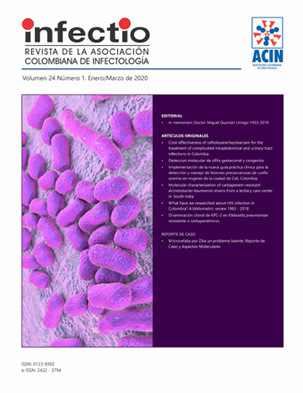Molecular characterization of carbapenem-resistant Acinetobacter baumannii strains from a tertiary care center in South India
Contenido principal del artículo
Resumen
Objectives: Carbapenem resistantAcinetobacter baumannii is an important therapeutic and infection control challenge worldwide. In this study, we investigated the prevalence and distribution of molecular mechanisms of resistance among carbapenem resistant A. baumannii species at a tertiary care setting in South India.
Materials and Methods: A total of 89 non-duplicate clinical isolates of carbapenem-resistantA. baumannii were collected from critical care units of St. John’s Medical College Hospital, Bengaluru, India. Polymerase chain reaction (PCR) was performed to detect blaOXA type carbapenemase blaOXA-51-like, blaOXA-23-like, blaOXA-24-like and blaOXA-58-like, MBL genes blaNDM, blaIMP, and blaVIM genes. Molecular typing of carbapenem-resistant A. baumannii strains was performed by using Rep-PCR.
Results: Eighty-seven of the isolates were found to carry the blaOXA-51 gene and 81 (91%) isolates were found to have blaOXA-51-like gene and blaOXA-23, gene. The blaOXA-24 like gene was detected in two isolates of which one also carried blaOXA-51 like and one isolate carried blaVIM coding gene. The prevalence of blaNDM, blaIMP, blaVIM genes was 12(13%),14 (16%) and 57(64%) respectively. Cluster analyses revealed a 90% similarity and were divided into 5 clusters. Most of the isolates containing carbapenemases coding genes grouped under cluster A, C and UC. Considerable heterogeneity was observed within UC cluster indicating circulation of multiple strains of A. baumannii within our institution.
Conclusions: Carbapenemase coding blaOXA-23, blaOXA-24 and blaOXA-51 -like were more common than blaVIM and blaNDM. The presence of blaNDM with other genes coding for carbapenemases indicate the ability of the strains to acquire novel genes despite having its share of the blaOXA like carbapenemase.

